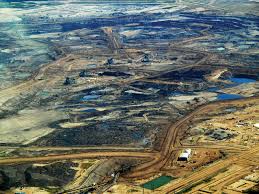
Tar Sands Companies “Selling Crown Jewels” to Survive
Desperate times mean desperate measures. Something has to give. With no end in sight to the low oil price, Canadian tar sands companies are having to sell what are being described as their “jewels in the crown” in order just to survive.
Desperate times mean desperate measures. Something has to give. With no end in sight to the low oil price, Canadian tar sands companies are having to sell what are being described as their “jewels in the crown” in order just to survive.
Producing dirty oil at high cost in a low cost era is fundamentally flawed. There is only so long that a company can produce oil at $80-100 a barrel and sell for $30 before something has to give.
The Canadian press has reported that tar sands companies are “sacrificing” other parts of their business to keep the tar sands operations going and “safeguard the billions already invested in these multi-decade projects.”
Big name companies such as Husky Energy, MEG Energy Corp and Pengrowth Energy Corp are said to be selling assets or slowing conventional oil and gas production so that they can carry on exploiting the tar sands, or as the press reports put it, carry on “bleeding money on every barrel”.
Grant Kernaghan, Canadian Investment Banking head for Citigroup, says that the assets these companies are selling are to a certain extent “the jewels in the crown. These companies would not be looking to sell them if they could get away with not doing it”.
Now you could argue that this is essentially throwing good money after bad. Not only are the tar sands highly expensive to produce they are also very carbon intensive. It would make sense in a carbon-constrained world to sell or ditch the carbon-intensive projects first.
But common sense often does not prevail in the oil industry. Just ask Shell which just blew $7 billion in a flawed oil search in the Arctic.
Even the Canadian press call the logic “counterintuitive”, although they outline how tar sands “companies take a longer-term view that shutting plants in Alberta would be very expensive and risk permanently damaging carefully-engineered reservoirs, underground deposits of millions of barrels of tarry bitumen.”
Essentially it is “it is easier, and cheaper, to shut down and later restart conventional wells.” But that only works in the short-term and does not factor in the need to address climate change and the fact that many of the tar sands risk becoming stranded assets that can never be burnt.
The increasingly stark future for the tar sands is becoming increasingly apparent. Earlier in the week I blogged how the only tar sands mine in the US was being put on hold.
And then there is another problem – the expensive dirty tar sands is increasingly competing with renewables which are getting cheaper by the day.
As one blogger on the Motley Fool website notes: “Even if oil prices recover quickly, oil sands projects may be doomed to fail anyhow. In the past 20 years the price of both wind and solar power has dropped by over 95%. Meanwhile, production of wind turbines and solar systems has exploded.”
Jeremey Grantham, co-founder of $120 billion asset manager GMO LLC tells the website. “I don’t think that if you put billions of dollars into a new tar sands project that you will see a decent return on it. It will be underpriced by solar, wind and other alternatives which are moving at considerable speed.”
So even the flawed strategy of selling the “jewels” in the crown may not be enough. Soon the once-invincible tar sands kingdom itself may come crashing down.

